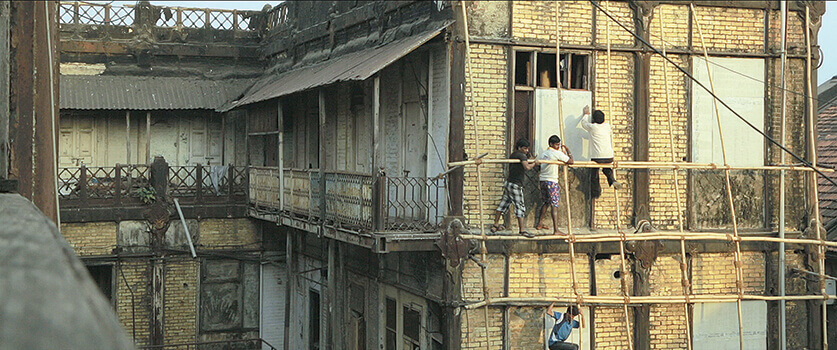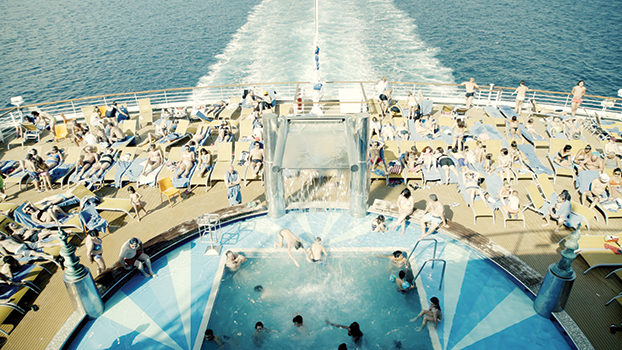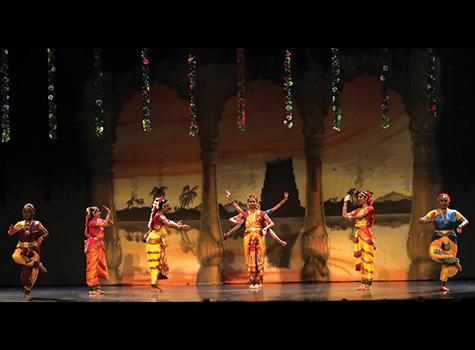
The 22nd annual Full Frame Documentary Film Festival returns to Durham, NC on Thursday, April 4 through Sunday, April 7, 2019. It is the country’s largest documentary film festival with over 80 films, along with many parties and other events. To date, they have shown over 2000 documentary films here in North Carolina.
If you’ve never been to a documentary film festival, try it out – it will likely keep you coming back every year. Sometimes true stories are more fascinating than fictional ones. Some of the topics that will be presented this year include an Aretha Franklin concert; an animal hospice; the dreams of a French ambassador’s wife in Burkina Faso of singing opera; Beto O’Rourke’s 2018 congressional campaign; rangers in Sudan guarding the world’s last male northern white rhinoceros; and biopics on a variety of subjects, including Miles Davis, two stray dogs in a Chilean skate park, and 90-year-old Holocaust survivor Dr. Ruth Westheimer who gained fame for her “frank and exuberant advice” on intimacy. One of my favorite films, Godfrey Reggio’s Koyaanisqatsi (Hope for “life out of balance”) will be shown – seeing this cinematic tour de force critique of modern development on the big screen will be a treat!
The list of films and schedule was released shortly before Saathee went to press. I was only able to see one film that takes place in India, The Watson’s Hotel (2019, thewatsonshotel.movie), as well as a film, Giants and the Morning After (2018, facebook.com/GiantsandtheMorningAfter), about a small village in rural Sweden.
Filmmakers Ragunath Vasudevan, Nathaniel Knop, Peter Rippl have produced a film, The Watson’s Hotel, enjoying its world premiere here at Full Frame, about a historic building in Mumbai, Watson’s Esplanade Hotel. Completed in 1863 and the oldest surviving cast iron building, this once grand Europeans-only hotel is now called the Esplanade Mansion. All of its materials, down to the nails and screws, were imported from England and assembled on site 1860-1863.

Located in the Kala Ghoda arts district of downtown Mumbai, it now has about a hundred commercial offices, mainly of lawyers serving the neighboring courts, as well as houses of dozens of families. Though expense wasn’t spared, inevitably the nineteenth century heritage structure today is falling apart; the film describes balconies falling to the ground and, in one case, a desk and its occupant falling through the floor.
The building has a colorful history. Jinnah, Pakistan’s founder, frequented the hotel and Mark Twain wrote about Mumbai in his Following the Equator when he was a guest. In 1895, the French Lumière Brothers made history when, with their Cinematographe device, they gave the first public screening of a film; just a year later in 1896, their employee Maurice Sestier came to Mumbai on his way to Australia to host, at Watson’s Hotel, the first film screening in the subcontinent.
The film is a glimpse into the building from sunrise to nighttime and is notably accompanied by Elgar’s The Crown of India, written for a 1912 theatrical show in honor of King George V and Queen Mary’s visit for coronation as Emperor and Empress of India. The choice of music, with its gorgeous sitar, composed for the film by Ketevan Scheipner, intermingled with orchestra, is perfect in reinterpreting the imperial music and looking back at Colonial India in this impressionistic serenade of the building.
In interviews with resident-workers like the elevator operator and his brother and the night watchman, as well as restaurant owners and lawyers in the building, a spectrum of historical and contemporary experiences are superimposed with the goings on outside the “mansion”. Residents bring artifacts, like early newspaper articles about events at the Hotel and a historic book that struggles in its dilapidation, as well as many stories such as how their forebears took up positions that they now have or how Iranian immigrants have contributed to the area’s culinary culture.
I enjoy films like these that help to ground history in real artifacts and experiences. Though I found the film a bit slow at times, it perhaps is worthy of another viewing to absorb more of the tidbits of the quotidian in this vibrant Mumbai quarter, at this once-lavish building. Questions of whether or not the building will be improved and how the lifestyles of those connected to the building will change remain with the viewer.
Ydre, in southern Sweden about 200km from Stockholm to the northeast and Gotenberg to the west, is one of the smallest municipalities in the country. According to Wikipedia, the population as of December 31, 2018 was 3,743 and the three largest cities had populations of 873, 490, and 304 (yes, the three largest!). It’s also the locale of mythological giants, including a goring cow.

Giants and the Morning After gives us a leisurely look at this quiet corner of Sweden. The mayor often frets about the population count, poring over census data with his assistant to find increases by the ones and twos. When a baby is born, he visits the family with a gift and says he hopes that he will be back again many times (to welcome more children). His endearing touch extends to such activities as welcoming a politician from Stockholm and suggesting legislation to make influx more attractive; expressing compassion for Syrian refugees and welcoming them to Ydre; encouraging the arts (we see high school students in audition for and then performing the musical Annie) and few local industries to draw people; and excitedly hand re-lettering the entrance to a new housing development to show that one more house has sold.
We get peeks into the lives of the folks who live here. A newly pregnant woman gets advice from an older sister. Tourists come on a bus and get an intimate and friendly welcome, including visits to the bus driver’s family members. A young couple leaves because they want more exciting opportunities. All of this is punctuated with readings about their legendary giants and evocative imagery.
The quiet pace of the film never really gets to the point of boredom, at least for me. It reflects both Ydre’s connection to the past and its careful consideration of where it might want to go. They are well grounded with their mythology and beautiful sylvan landscape. However, in a country with one of the fastest urbanization rates in Europe, Ydre constantly faces being absorbed into a larger municipality. How much and how fast should they try to develop? There are clear benefits to modernity but what cost is paid for it?
The Watson’s Hotel is being shown along with a 10-minute short film on Friday, April 5 from 4-6pm in Cinema 1 of the Carolina Theatre. The preceding short, All Inclusive (2018, someshorts.com/movies/allinclusive), depicts sometimes bizarre behavior that becomes the norm on a large cruise ship. Giants and the Morning After is being shown on Saturday, April 6 from 1:10-3:05pm in Cinema 4.
I always look forward to four solid days of memorable and impactful films. We’re lucky to have this Festival here in the Carolinas; this year, there were almost 1700 new films submitted, from which 67 (from 28 countries!) were selected (in total, there are 83 films, including invited and curated ones). One of the films that wasn’t selected was my debut as an Executive Producer, code blue (2019, codebluedoc.com) about lifestyle medicine to prevent, manage and possibly reverse chronic diseases; I will present this in a future issue of Saathee.
The best way to attend Full Frame is to purchase a pass, and this year again some classes of passes sold out very quickly. This year, there is a new “last minute” Rush pass for only $30; tickets will now no longer be sold in the last minute lines. There is again a Sunday 4-pack for $25.
Tickets for individual films can be purchased online, by phone, or at the Duke University Box Office. During Full Frame, sales typically end two hours before show time and cost $16 with a $2 discount available to the Duke community, seniors, students, military, police, firefighters, and teachers.
There are always free events, including some panel discussions and Friday and Saturday night outdoor film screenings of films from the previous year’s Festival. These screenings are often particularly good for families who are welcome to picnic and enjoy the showing at Durham’s Central Park just a few blocks from the Festival.
It’s important to keep in mind that many films do sell out. If there is a film that you really want to attend but it has “sold out”, there still may be hope. If you have a pass, including the new Rush one, you should plan to go to that film’s “last minute line” at least 30-45 minutes before the film is scheduled to start. Also, some of the invited films are usually shown at multiple times, and some of the films chosen for awards reprise on Sunday afternoon. The crowds significantly thin after lunch on Sunday, so tickets should be readily available for those encores.
The Festival features over a half dozen venues, mostly in and around the historic Carolina Theatre in downtown Durham at 309 West Morgan Street. Theatres range in size from 50 to 1000.
Because films are shown in parallel, it may not be possible to see all that one may want to see. Some films are ultimately released for a theatrical run or perhaps to be shown on television, but this can be months or even a year or more later. Many films only play the festival circuit, perhaps only Full Frame.
Insightful film discussions, relaxation at parties and around the venues, and dining at the growing number of good restaurants in downtown Durham are all great draws for the Festival. Full details, including the complete schedule of events and film descriptions, are available at www.fullframefest.org.



